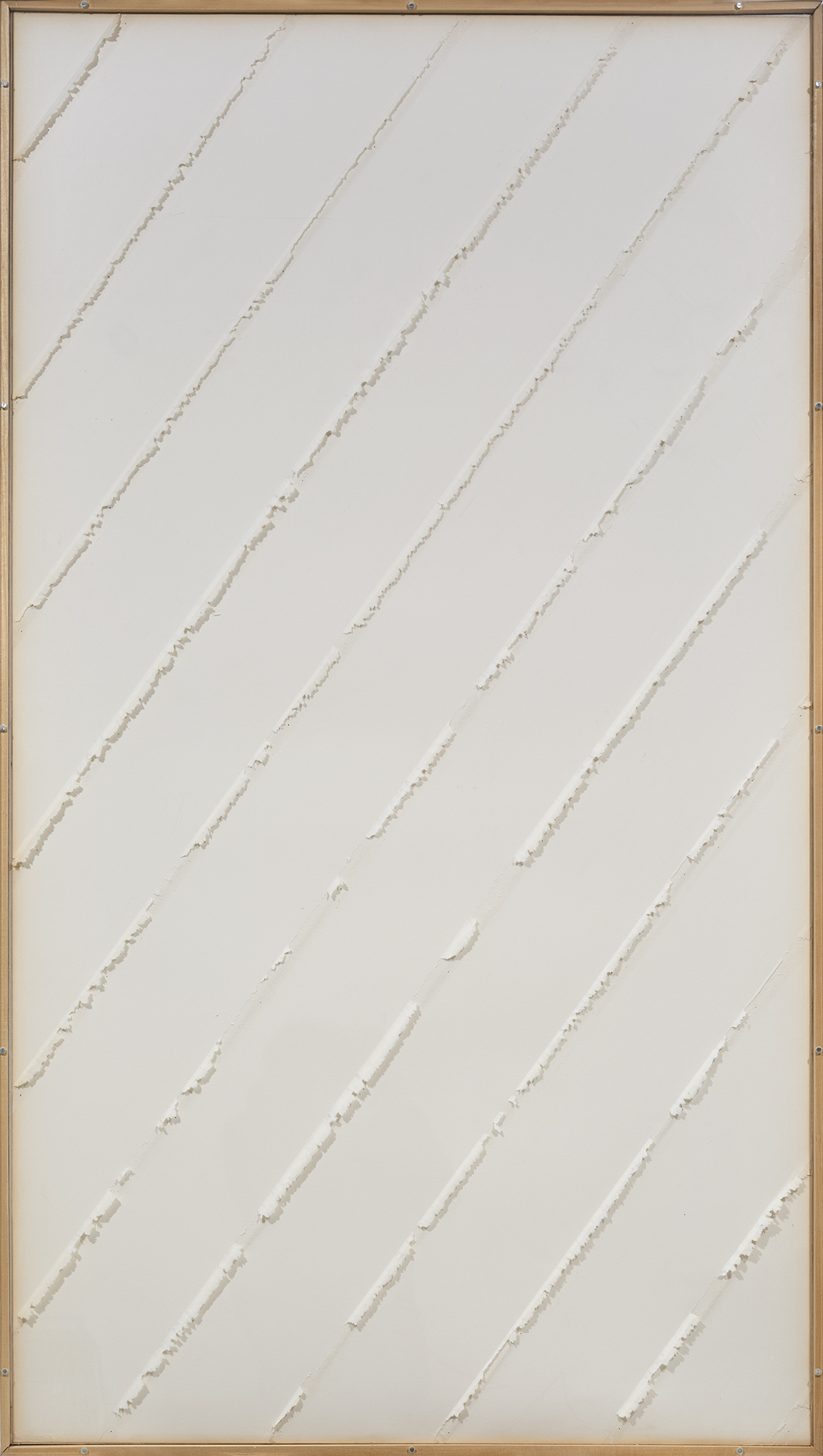Jean DegottexPapier Plein Oblique n18
1976
velin paper 400g
66.93 x 37.4 in ( 170 x 95 cm )ZoomInquiry - Papier Plein Oblique n18, 1976
Provenance
Galerie Mennour, Paris
Private Collection, Paris
Artwork's description
Jean Degottex, a major figure of abstraction in France, explores a complete break with pictorial conventions in his series Suite Papiers-Pleins (1975–1976). In this series, which includes Papier Plein Oblique n°18 (1976), he abandons traditional painting in favor of a physical and tactile approach to paper. This transition from pictorial gestures to working directly with the material reflects a profound meditation on materiality and space.
The work is based on precise gestures: tearing, lacerating, folding, and transferring, transforming paper into a field of experimentation. Initially, Degottex examines the interactions between the paper's surface and its environment through active and dynamic marks. These interventions create imprints and traces where the interior and exterior of the paper resonate with one another. Later, he simplifies his actions, focusing on the mere lifting of the paper, emphasizing its intrinsic integrity. The result is a series where each variation, systematically repeated, seems to push the sheet toward poetic and meditative saturation.
Artist's biography
Jean Degottex, born on February 25, 1918, in Sathonay-Camp, into a modest family, spent his childhood in Lyon. At the age of fifteen, he moved to Paris with his parents, leaving school to enter the workforce. It was in the French capital that he frequented libertarian circles and took part in drawing and painting sessions at free academies, notably the Académie de la Grande Chaumière. It was also during his military service in Tunisia and Algeria, from 1939 to 1941, that Degottex painted his first canvases, characterized by a fauvist and figurative inspiration.
Degottex's artistic career took a decisive turn in 1941 when he decided to devote himself entirely to painting. He exhibited at the Salon des moins de Trente Ans. In 1946, he married Marie-Rose (Mirose) Patrix, sister of the artist Michel Patrix, and their daughter Frédérique was born in February 1947.
From 1948 onwards, Degottex embraced abstraction definitively, developing a gestural painting that placed him among the leading figures of lyrical abstraction. In 1949, he exhibited for the first time at Denise René's gallery, renowned for its support of abstract avant-gardes, and later at the Galerie de Beaune. That same year, he began a relationship with Renée Beslon, a poet, visual artist, and art critic, who would remain his companion until his death. In 1951, he was awarded the prestigious Kandinsky Prize. From 1954, his works showed an increasingly radical abstract gesturality.
In 1955, Degottex joined the Kléber gallery, led by Jean Fournier, where he maintained sometimes tumultuous artistic relationships with Simon Hantaï and Georges Mathieu, and formed friendships with the poet Bernard Heidsieck, as well as the artists Françoise Janicot, Jean Dupuy, and Paul Armand Gette. In 1959, he joined the Galerie internationale d'art contemporain directed by Maurice d'Arquian.
The period from 1956 to 1963 was particularly prolific for Degottex, marked by the creation of numerous large-scale works, often organized in series such as Ashkénazi (1957), Serto (1957), Hagakure (1957), the 18 Vides (1959), the Roses (1960), the Alliances (1960), the 7 Métasignes (1961), and Jshet (1962). These works were characterized by a fusion of prolonged meditation and spontaneous execution.
The tragic loss of his daughter Frédérique at the age of 16 in 1963 plunged Degottex into a period of despair and inactivity. However, he resumed his work with the series Écritures, followed by the Rose noire (1964), Suite obscure (1964), Métasphère (1966), Etc (1964-1967), and Horsphères (1967). From 1966, Degottex spent long periods working in Gordes, in the Vaucluse.
In 1968, he actively participated in the graphic creation movement that accompanied the events of May 68. In 1969, he collaborated with the architect Jean Daladier on the design of dome houses in Saint-Julien-du-Sault and exhibited at the Musée d'art moderne in Paris.
From 1972 to 1976, Degottex organized several solo exhibitions at the Galerie Germain and returned to exhibit at Jean Fournier's gallery. He explored new artistic techniques, working on paper with tears and collages, and using the "report" technique by folding, as evidenced by the series Lignes-Report (1978) and Plis-Report (1978).
In 1979, for a solo exhibition at the Abbaye de Sénanque, he created the Déplis series, which included numerous large Déplis-Bleu. In 1981, he received the Grand Prix national de peinture. In 1982, he joined the Galerie de France, directed by Catherine Thieck, and created the Grilles-Collors, Oblicollors, and Diacollors series. His last major works, Lignes-Bois (1985) and Contre-Lignes Bois (1986), were characterized by white, gray, and blue-gray tones.
Jean Degottex died in Paris on December 9, 1988, leaving behind an artistic legacy marked by innovation and an unceasing quest for new forms of expression.
